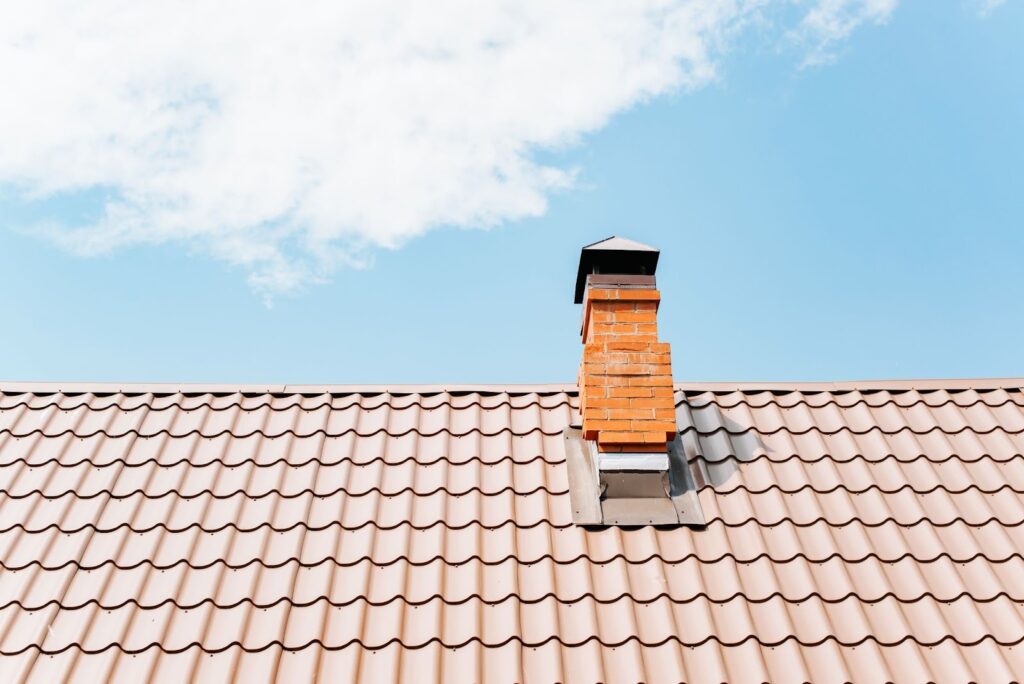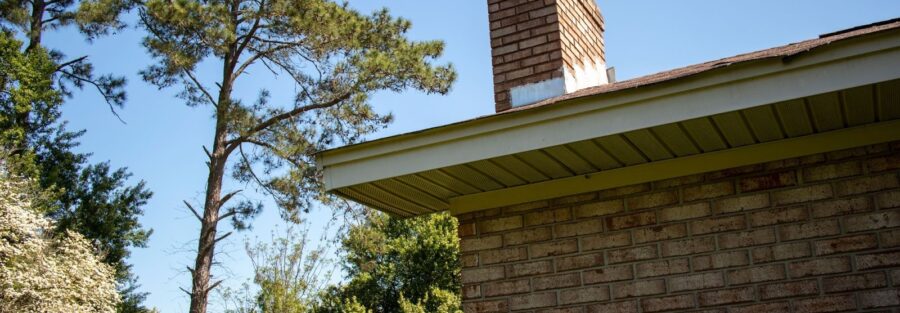If you’ve noticed stains near your fireplace, peeling paint by the chimney, or water marks on ceilings after a storm, chances are your flashing is to blame. Chimney flashing repair might sound like a small job, but it prevents big, expensive problems, such as rot, mold, damaged framing, and even masonry failure. Whether you’re planning a quick roof check in DFW Texas or dealing with the aftermath of a hailstorm, we make the process simple and stress-free.
At Alpine Roofing, we specialize in residential and commercial roofing across the Dallas–Fort Worth area, and we stand behind every project with a full warranty. In this guide, we’ll walk through what flashing does, how to recognize early signs of trouble, your repair options, and when it’s time to call our local DFW roofing experts for a professional chimney flashing repair.
What Chimney Flashing Does and Why It Fails

Chimney flashing seals the vulnerable joint where your roof meets the chimney. This area is one of the most leak-prone parts of any home. When installed properly, flashing channels water safely away from the chimney and off the roof. When neglected, corroded, or improperly fitted, it becomes a direct entry point for water into your attic and walls.
Most systems include three main components: step flashing, counter flashing, and apron flashing. Step flashing is made of L-shaped metal pieces woven between shingles up the sides of the chimney. Counter flashing is embedded into the chimney’s mortar joints and overlapped over the step flashing to form a watertight barrier. Apron flashing sits at the downslope of the chimney, guiding water back onto the roof surface. On the upslope side, wider chimneys often need a cricket, a small ridge that splits water and debris, preventing pooling.
Leaks typically occur when these materials begin to corrode, when temperature swings cause expansion and contraction that loosen fasteners, or when mortar begins to crumble. Even a hairline crack can allow rain to channel behind the flashing. If you suspect flashing failure, it’s best to act quickly. You can learn more about our inspection and repair approach through our roofing services page.
How to Spot Flashing Problems Early
Water doesn’t always show itself immediately. In fact, the earliest signs of flashing damage often appear indoors. You might notice yellow or brown stains forming on ceilings or walls near the chimney, peeling paint or bubbling drywall around the fireplace, or a musty odor that lingers after heavy rain. In attics, white powder (called efflorescence) or darkened brick near the chimney base can also signal moisture intrusion.
From the ground, a pair of binoculars can help you spot visible damage without the danger of climbing onto a roof. Look for rusted, lifted, or missing sections of metal, cracked mortar joints, or dried and split sealant. Curling shingles where they meet the chimney are another sign water is getting through. If you notice any of these, it’s time to call for a closer look. Schedule a quick inspection through our contact page, and we’ll confirm if a flashing repair or replacement is needed.
Repair Options: Seal, Patch, or Replace

Not every flashing leak means you need a complete rebuild. The right fix depends on the condition of your materials and how the system was originally installed. For smaller issues, applying a high-quality, UV-stable roofing sealant can close gaps and reinforce joints where flashing meets the masonry. This is best treated as a short-term solution—perfect for small leaks or as a bridge to a scheduled replacement, but not a permanent fix.
If counter flashing is still intact but loose, re-cutting and re-bedding it in fresh mortar can extend its life. Minor rust spots may also be patched, provided the surrounding metal remains solid. In these cases, we always verify the integrity of the apron flashing and shingle integration to make sure water is being directed properly.
A full flashing replacement becomes necessary when corrosion is widespread, the existing installation was done incorrectly, or the mortar joints have failed entirely. Our team removes old components, repairs the underlying structure, installs new step flashing with each shingle course, and sets new apron and counter flashing. If the chimney’s slope or width creates water buildup, we add a properly sized cricket for improved drainage. If you’re unsure which route makes the most sense, we’ll evaluate your roof and provide a straightforward recommendation during your inspection. You can schedule one through our roofing services page.
Materials, Tools, and Safety Considerations
The best chimney flashing repairs are the ones that last through years of Texas heat and stormy weather. Galvanized steel remains a common, affordable choice, though it must be properly coated to resist rust. Aluminum offers excellent corrosion resistance but can dent more easily, and copper provides unmatched longevity and a refined look, which is ideal for historic or high-end properties.
We pair step flashing with a waterproof underlayment membrane for redundancy, ensuring the intersection is protected even during driving rain. Counter flashing is always set into mortar joints rather than surface-glued, creating a clean, lasting bond. Every project is performed with strict safety measures. We only work in dry, stable conditions, using harnesses, ladders, and roof jacks as needed. Heat and humidity also factor into when certain sealants or membranes can properly cure, so we plan around weather windows for long-term performance.
If you’re debating whether to handle this yourself, leave the ladder in the garage. Our DFW roofing experts can handle your chimney flashing repair safely and efficiently. Get in touch through our contact page.
Professional Repair Process, Costs, and Timelines
When we handle chimney flashing repair in DFW, our process begins with a detailed inspection. We check the roof exterior, attic, and surrounding framing for signs of moisture, rot, and shingle wear. Using moisture mapping tools, we trace the path of leaks and evaluate the brick and mortar to determine whether additional masonry work is required.
After protecting your landscaping and interior spaces, we remove compromised metals and sealants. The decking, underlayment, and mortar joints are repaired as needed before we install new step, apron, and counter flashing. If required, a cricket is added to manage uphill water flow. We complete every repair with a controlled water test to confirm proper drainage and sealing.
Pricing depends on scope and materials. Minor sealing or patchwork may range from a few hundred dollars, while full replacements typically begin around a thousand. We provide written warranties on craftsmanship and help customers coordinate with insurance when storm damage is involved. For a clear, no-pressure estimate, contact our DFW team through our contact page.
Preventing Future Leaks and Extending Service Life

In North Texas, heavy rain, hail, and temperature swings can quickly stress even well-installed flashing. Regular maintenance keeps your system performing at its best. Inspect the flashing annually for rust, lifted edges, or cracked mortar, and check your attic after major storms for new stains or damp insulation.
Adding or maintaining a properly fitted chimney cap helps prevent water intrusion from above, while a cricket on the uphill side of wide chimneys diverts debris and runoff. If your home includes siding or stone transitions around the chimney, make sure those seams are sealed and flashed correctly to avoid water infiltration.
When leaks involve flashing, shingles, or roof intersections, it’s best to call a professional roofer like us. If the issue involves cracked or deteriorating masonry, a mason may need to step in. Many projects require both trades, and we’re happy to coordinate for a seamless result. For homeowners who want proactive care beyond chimney flashing repair, our restoration services provide comprehensive solutions for storm-related damage.
Conclusion
In DFW Texas, where wind, hail, and heat constantly challenge roof systems, chimney flashing repair offers powerful protection against water intrusion. What seems like a small fix can prevent major structural damage and costly restoration later. If you’ve noticed staining, rusted metal, or cracked mortar, don’t wait for the next downpour to make things worse.
For fast, reliable chimney flashing repair and full-service roofing support, contact Alpine Roofing through our contact page or call +1 682-257-4631.
Alpine Roofing proudly serves the Dallas–Fort Worth area from our office at 7247 Kentish Dr, Fort Worth, TX 76137. You can reach us at +1 682-257-4631 or email info@alpineroofingandsolar.com.
Chimney Flashing Repair FAQs
What is chimney flashing and why does it fail?
Chimney flashing is the metal system that seals the joint where your roof meets the chimney. Leaks occur when the metal corrodes, fasteners loosen due to temperature movement, or mortar joints crack, letting water seep behind the counter flashing.
How can I tell if I need chimney flashing repair?
Ceiling stains, peeling paint near the fireplace, musty odors, or discolored brick in the attic are warning signs. From the ground, look for rusted or lifted flashing and gaps where shingles meet the chimney.
Is sealing enough, or do I need a full replacement?
Sealing can bridge small gaps temporarily, but if corrosion or poor installation is widespread, replacement is the better long-term solution.
Can I DIY chimney flashing repair?
DIY fixes often miss hidden leak paths and can void warranties. Proper repairs require technical precision and safe access equipment. Hiring a professional ensures long-lasting, code-compliant results.
How long does new chimney flashing last in Texas?
Depending on the metal used and exposure conditions, galvanized steel may last 10–15 years, aluminum about 20, and copper more than 30. Regular maintenance and correct installation help extend service life.




